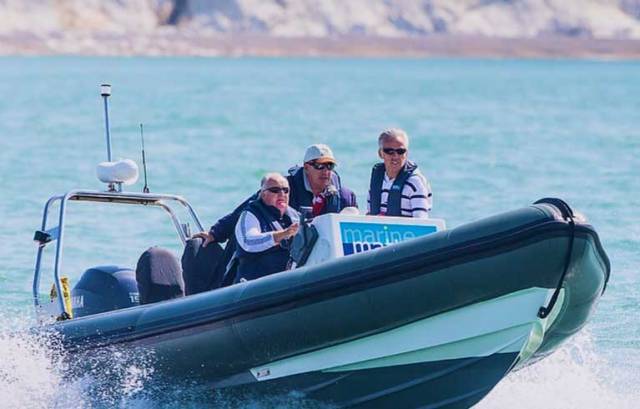He was in the key role of Commodore when Dublin Bay Sailing Club was successful in implementing the changeover from pier to Committee Boat starts which involved the complete re-structuring of its course programme in the Bay, and many other novel features. And he was right there when the Irish Cruiser Racing Association came into being as a very successful pioneering project to represent and work on behalf of one of the largest segments of the Irish sailing community, a sector whose unique needs had never been directly addressed before.
Then when Ireland became a force to be reckoned with in the biennial International Commodore’s Cup series in the Solent, he was a member of the support team which contributed to the smooth running of campaigns which saw our sailors achieve the overall victory in 2010 and 2014. Yet at the same time he enjoys his own active and varied sailing career in a wide variety of boats at a remarkable range of locations. W M Nixon gets together with a man who has been central to fundamental and successful changes in Irish sailing during the past 25 years and more.
Back around 2001, it was a vigorous time for Irish sailing. The new marina in Dun Laoghaire had recently opened, sailors and boat numbers were increasing at all centres, and new systems in established administrations were being created to meet a soaring demand for better facilities and race management.
Dun Laoghaire had become a very happening place, so one Saturday morning early in the Spring before the new season was properly under way, we sailed our Howth-based cruiser across Dublin Bay to the newly in-marina Royal Irish YC to grab a spot of bar lunch, have a bit of banter with the locals, and inhale the atmosphere in what had become Irish sailing’s liveliest place.
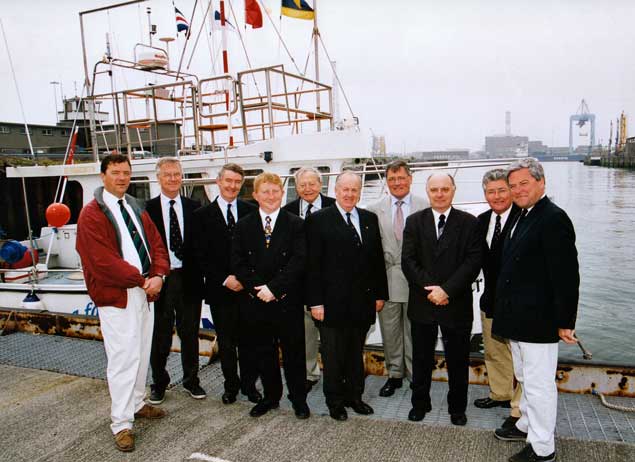 At the handing over of the new Dublin Bay SC Committee Boat Mas Lir, sponsored by Dublin Port. Commodore Fintan Cairns is fifth from right, with DBSC Honorary Secretary Donal O’Sullivan on his right and Captain Enda Connellan, CEO Dublin Port, on his left.
At the handing over of the new Dublin Bay SC Committee Boat Mas Lir, sponsored by Dublin Port. Commodore Fintan Cairns is fifth from right, with DBSC Honorary Secretary Donal O’Sullivan on his right and Captain Enda Connellan, CEO Dublin Port, on his left.
Berthed beside the club was the newest addition to the local fleet. It was Dublin Bay Sailing Club’s recently acquired Committee Boat, the catamaran Mac Lir sponsored by Dublin Port. This distinctive purpose-designed vessel was the symbol of the changeover to a much-greater emphasis on Committee Boat starts for all DBSC races, which in turn had required a radical re-design of DBSC courses.
For a club which had been central to Dun Laoghaire racing since 1884, it was a huge changeover in the way of doing things. But thanks to the quietly persuasive powers of DBSC Commodore Fintan Cairns, it had been achieved with skill and general approval, and this new way was going to be fully inaugurated the following week.
There’d been nobody aboard Mac Lir as we headed into the welcoming berth at the RIYC. But as we departed in good cheer, somebody was busy aboard, bent over at various jobs on the afterdeck. He straightened up as we headed seaward, and gave us a cheery wave and called a greeting. It was Commodore Fintan Cairns. And we thought it was altogether typical of the man, that he should be quietly checking out the club’s new boat and her systems himself, with no fuss or bother.
That’s the way it is with Fintan Cairns. He is a superb delegator and a quietly brilliant persuader. But when something that benefits best from personal attention comes up on the agenda, he’s ready and willing to look after it to his own satisfaction, and without fuss.
He does all this in such an affable and low key way, ready for everyone with a quiet greeting and his unflamboyant gift of friendship and genuine personal interest, that we all feel we know him well. At first glance, he seems a man of sombre demeanour. But his face lights up with good conversation and effective problem-solving discussion, and the real Fintan Cairns, bubbling with ideas and receptive to the notions of others, soon emerges.
So when the sunny images of the first race of the well-supported Turkey Shoot 2017 for the large DBSC fleet appeared a couple of weeks ago on Afloat.ie to blow away the November gloom in a splash of bright colour, it was recalled that this was yet another Fintan Cairns-inspired idea.
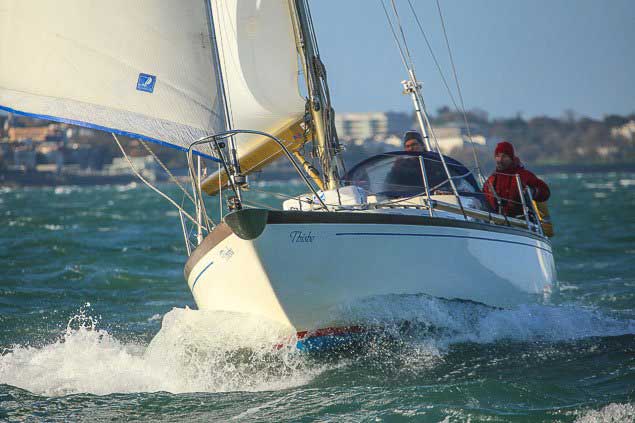 A flash of very welcome brightness in November. Such is the enthusiasm for the Fintan Cairns-inspired annual Turkey Shoot series in Dublin Bay that even a vintage Nicholson 32 is enthusiastically involved. Photo David O’Brien/Afloat
A flash of very welcome brightness in November. Such is the enthusiasm for the Fintan Cairns-inspired annual Turkey Shoot series in Dublin Bay that even a vintage Nicholson 32 is enthusiastically involved. Photo David O’Brien/Afloat
And he was right there for 2017’s Turkey Shoot, on the newer DBSC Committee Boat Freebird, ensuring that the most interesting courses were being set, and seeing to it that everyone was finished by 1230pm in time for that precious focus of concentrated après-sailing socializing which knocks for six the dark prospect of encroaching winter.
It’s a good example of the continuing success of a Fintan Cairns vision for making the Irish sailing scene more interesting. But in contemplating this success, we suddenly realized we didn’t really know Fintan Cairns at all. When somebody becomes as quietly important in Irish sailing as this, albeit in a very low key way which is only appreciated by true sailors, it’s intriguing to find out a bit more about their back-story, and how it has brought them to our sport with such a fresh attitude, receptive to new ideas, and central to Irish sailing’s development.
Although his earliest childhood was in Kilmacanogue in County Wiclow, he’d soon become a south Dubliner through and through. His grandfather owned a furniture-making factory with a large retail outlet in the city, and had a boating interest with an early glassfibre motor-cruiser on the Shannon. Young Fintan was mildly enthusiastic about boats himself, and enjoyed using them on family holidays to the sun. But his main interest in boyhood and early manhood was in rugby, and he went on to play and coach with Palmerstown.
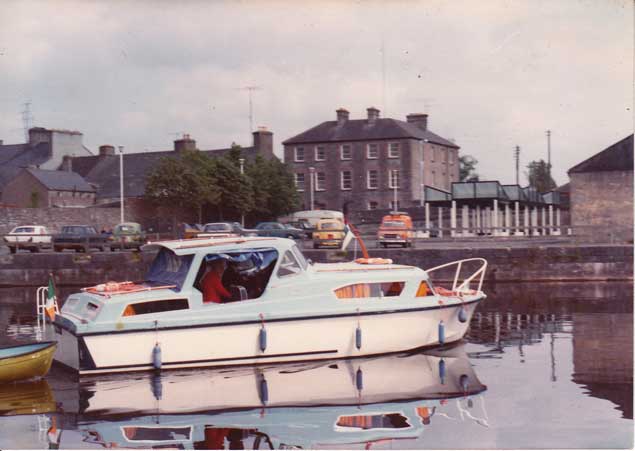 First interest afloat – the grandfather’s early GRP motor-cruiser at Carrick-on-Shannon
First interest afloat – the grandfather’s early GRP motor-cruiser at Carrick-on-Shannon
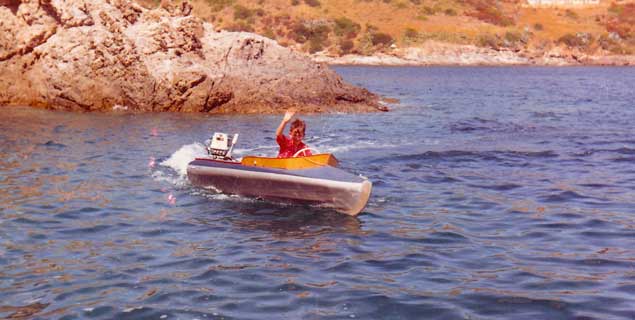 Boy racer – a very young Fintan Cairns gets a taste for sport afloat on a family holiday in Elba in 1962
Boy racer – a very young Fintan Cairns gets a taste for sport afloat on a family holiday in Elba in 1962
However, an acquaintanceship with Philip Smith blossomed into friendship with a sharing of Smith’s interest in sailing with his Dufour 27 Jasmin, and they became involved with Dun Laoghaire Motor Yacht Club. They gradually were drawn into Cruiser 3 racing with the big fleet with Dublin Bay SC, but a life-changing experience was a cruise with this little boat round Land’s End and up the English Channel as far as Cowes, before crossing the channel to Jersey and then returning to Dublin Bay, with more confidence in their sailing and seagoing ability accruing with every passing mile. Sailing was now definitely the Number One leisure interest.
Back home again, they involved themselves with Cruisers 3 racing with even more enthusiasm, and Fintan became the Jasmin representative on the Cruisers 3 Committee. As his administrative and negotiating abilities became evident, he was soon appointed Class 3 Captain, and that in turn involved membership of the DBSC Committee.
Meanwhile, in shore life he’d made it clear that the furniture business was not for him. Instead, he trained as an accountant, and in time he made his career as the financial controlling partner in a private yet substantial builder of houses. Having made this his working interest, it probably explains why he is willing to get into the running of almost any organisation in sailing provided it doesn’t involve the maintenance of bricks and mortar……
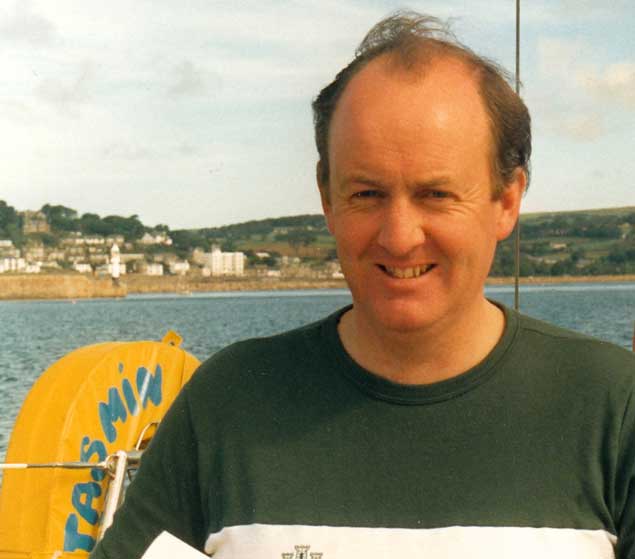 Getting a taste for proper sailing – the young Fintan Cairns on Philip Smith’s Dufour 27 Jasmin during their key cruise to Cowes and the Channel Islands
Getting a taste for proper sailing – the young Fintan Cairns on Philip Smith’s Dufour 27 Jasmin during their key cruise to Cowes and the Channel Islands
Shore life had settled down with a happy marriage to Hilary and two sons, while the Smith-Cairns sailing partnership with Jasmin prospered further with the quietly enthusiastic support of old friend Gay Moloney. But with his increasingly active participation in the DBSC Committee and broadening of his already wide range of sailing friends, other sailing and crewing opportunities for Fintan Cairns presented themselves, and for several decades he was extraordinarily active in a wide variety of craft ranging from the International Dragon to Class 1 offshore racers, which was to eventually include his organisation of several notable campaigns with chartered cruise-racers in the Caribbean and Mediterranean.
At the top end of racing at home, he learned from the masters such as Tony O’Gorman in the Dragons, he went to the Dragon glamour events with folk like John Finnegan and his classic Jane, and he honed his offshore skills aboard Frank Elmes’ Marissa in major events like the Round Ireland Race, while Dublin Bay and Howth racing were also further experienced with Jack Kirwan in the Ruffian 23 and Tony Brown in the S&S 30 Sunshot. In another interesting twist, he became the de facto crew boss aboard the Tripp 40 Infinity jointly-owned by Nobby Reilly and Alan
Chambers.
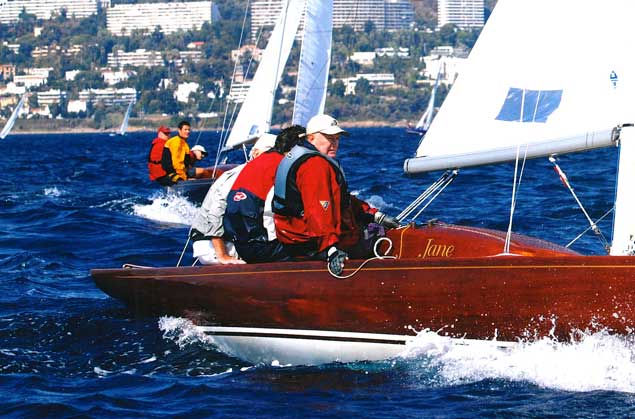 Fintan Cairns crewing John Finnegan’s classic wooden Dragon Jane in the Regatta Royale in Cannes
Fintan Cairns crewing John Finnegan’s classic wooden Dragon Jane in the Regatta Royale in Cannes
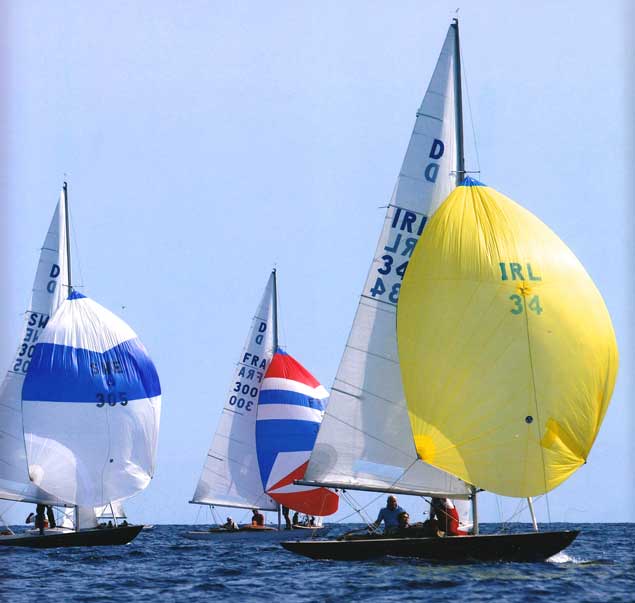 Despite being a classic of a certain age, on a good day Jane could have more modern international competition tucked in neatly astern
Despite being a classic of a certain age, on a good day Jane could have more modern international competition tucked in neatly astern
While the boat was based in Howth – a port with which he’d many links – the two owners were so busy that at times there’d be a preponderance of DBSC people in the crew. But although Fintan had been a coach in rugby, he didn’t feel he yet had the experience and skills to do the same in sailing, so when it was decided that Infinity would aim for major events rather than longterm participation in club series, he called on the services of David Harte for the intensive coaching of Infinity’s crew, and has remained a David Harte enthusiast ever since.
Ashore, his progress up the administrative ladder saw him becoming Rear Commodore and then Vice Commodore of DBSC. As a DBSC Flag Officer he was entitled to Honorary Membership of all the waterfront clubs, and he increasingly found he was using the Royal Irish YC as a convenient base for sailing meetings. He felt comfortable there and they were comfortable with him, and he was soon to make the RIYC his home club.
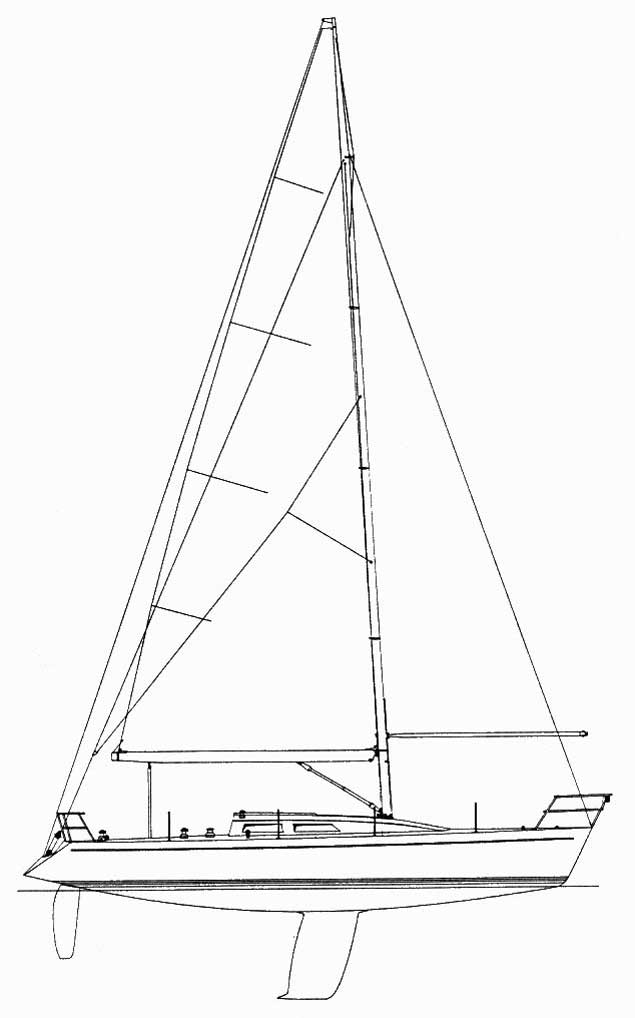 The Tripp 40 Infinity. Having become crew boss “by accident”, Fintan Cairns became enthusiastic about the special talent shown by David Harte in coaching the team
The Tripp 40 Infinity. Having become crew boss “by accident”, Fintan Cairns became enthusiastic about the special talent shown by David Harte in coaching the team
Inevitably one of the most demanding positions in Irish sailing - Commodore of Dublin Bay SC - was being seen by many as his next step. That was despite the fact that he’d quietly made it clear that once the marina was up and running, DBSC would have to modernize its functioning to match the growing new demand. But he got on well with long-serving DBSC Honorary Secretary Donal O’Sullivan, and he had good working relations with other major figures in Dublin Bay sailing administration. Well before the turn of the century it was clear that DBSC was going to embrace to the full the fresh possibilities which the 21st Century and Dun Laoghaire’s marina would offer, and Fintan Cairns was going to be the man keeping things cool in the hot seat of Commodore, while being fully appreciative and supportive of the long tradition of volunteering which keeps the enormous Dublin Bay SC machine up and running.
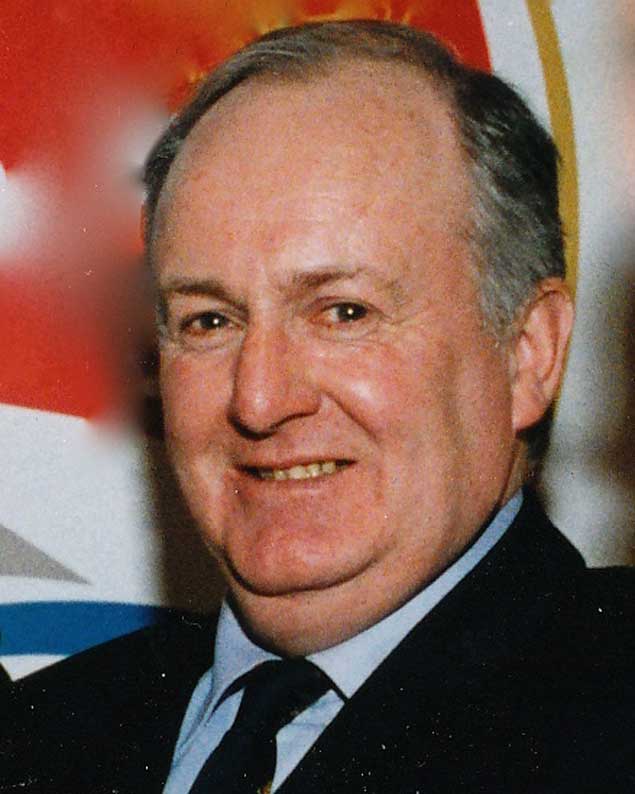 Fintan Cairns during his years as Commodore of Dublin Bay SC
Fintan Cairns during his years as Commodore of Dublin Bay SC
In addition to organising the funding of the new Committee Boat with sponsorship from Dublin Port, with whom DBSC was in any case in negotiations about the organisation of Dublin Bay traffic lanes and how their own sailing area could best accommodate the new reality of greatly increased shipping in and out of the port, Commodore Cairns and his Committee had to address how best to re-shape their courses to maximize the benefit of having the Committee Boat.
It was now that we saw the genius of his talent for delegation, for instead of looking within his own team, together with them he turned to Tim Goodbody, one of DBSC keenest and most successful racers, but one whose own administrative talents had been absorbed by being Commodore of the Royal Alfred YC when it was at a particularly active stage, and then Commodore of the RIYC.
Cometh the hour, cometh the man. Despite his long and trophy-winning sailing career in Dublin Bay as it had been, Tim Goodbody brought to the setting of the new courses an incisively fresh approach which reflected his successful national and international experiences.
In putting all this in train, Fintan Cairns is refreshingly frank about his readiness to learn from the experiences of other sailing areas. “Why reinvent the wheel?” is his attitude, and it was his observing of the success of catamarans as committee boats at major events in France which led to their introduction in Dublin Bay, while the style of the clear new colour-printed waterproof DBSC Race Programme based on Tim Goodbody’s work drew its finished appearance to some extent from the programme at Howth YC. There, they’d had to move to Committee Boat Starts well clear of the harbour after it had been re-developed in the 1980s as a sailing/fishing port complete with separate marina at one side and fish dock at the other, with specialist areas of activity clearly defined.
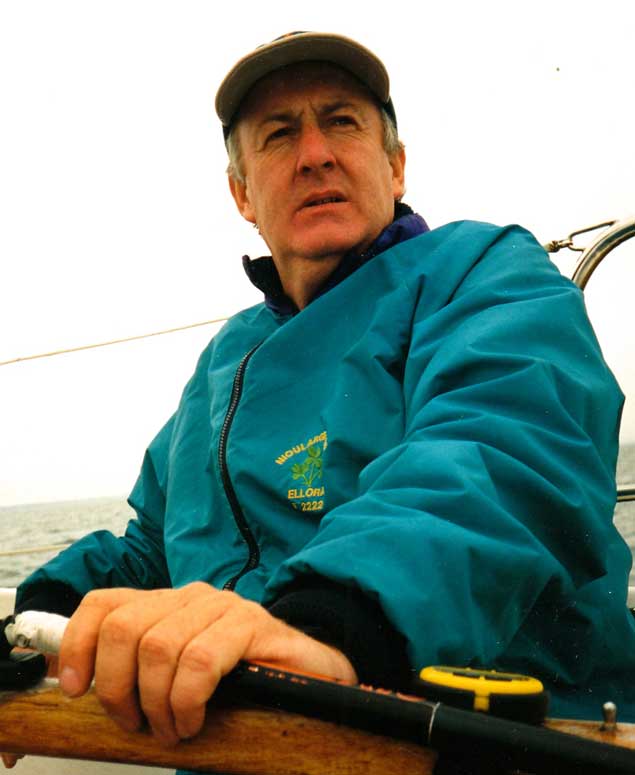 From being crew boss, Fintan Cairns has long since graduated to being a helmsman
From being crew boss, Fintan Cairns has long since graduated to being a helmsman
The new course setup got fully on stream in Dublin Bay through 2001’s regular programme. It was well able to cope with increasing boat numbers, though at the height of the economic boom years seven or so years later, sage heads such as Donal O’Sullivan reckoned they’d just about reached optimum numbers, of which cruiser-racers were far and away the largest group.
This fact of sailing life was being replicated in sailing centres throughout Ireland, and in 2002, when he had barely had time to get used to having finally retired as DBSC Commodore, Fintan Cairns found himself being approached from Cork by Denis Kiely of Kinsale and Jim Donegan of Crosshaven. Thoughtful sailors who already ran the South Coast Offshore Racing Association, they reckoned that the very specific needs of the rapidly-growing cruiser-racer fleets in Ireland required their own dedicated national association which would defend their interests with other sailing bodies and the national authority, and would hope to organise a national championship to provide recognised national titles of real status for this very significant sector of the sailing population.
The creation of the Irish Cruiser Racing Association began in a very low key way in the autumn of 2002 with an exploratory meeting between Denis Kiely, Jim Donegan and Fintan Cairns in the Granville Hotel in Waterford, and the first conference was held in February 2003 in Kilkenny. While numbers of cruiser-racers were large, their specific locations were widespread, but there was simply no denying the numerical strength and majority power of the Cork-Dublin axis. To get what was then a very novel concept up and running, this strength of numbers had to be acknowledged, and the first National Championship in 2003 reflected this, as it was staged in Howth.
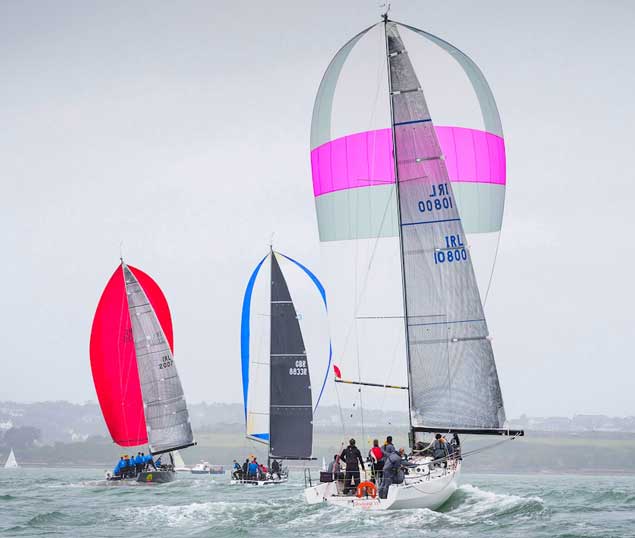 ICRA Nats 2017 at Crosshaven. First raced in 2003, this championship has become a major annual fixture. Photo Robert Bateman
ICRA Nats 2017 at Crosshaven. First raced in 2003, this championship has become a major annual fixture. Photo Robert Bateman
ICRA was run by a dedicated group of volunteers each of whom brought their special talents to the organisation. Jim Donegan, the elder statesman, was so much more interested in the wellbeing of the new organisation than in personal advancement that he insisted on Fintan Cairns being the first Commodore, while the distinguished Cork sailor was more than content to be Vice Commodore.
Initially, the highlight of the ICRA season was the National Championship, which is essentially self-limiting, as it is restricted to boats which have or would be eligible for an IRC Rating. Boats not actually rated but eligible were catered for by ICRA’s ace number-cruncher Denis Kiely, who took Ireland’s long-established native rating system ECHO to new heights, thereby providing for extra entries which brought fleet numbers at most annual national championships to comfortably above the hundred mark, particularly at the height of the boom years.
With championships every year at different venues, they sometimes shared the event with established regattas. But increasingly this important national championship was seen purely as a stand-alone happening, and a strong element of continuity was required in the administration, so the first Commodore was expected to serve for a demanding six years.
After six years of growth and consolidation, with the hotly-contested national championship successfully staged at a range of venues, Fintan Cairns was able to hand over the Commodore’s role to Barry Rose of Cork in 2009. But the Dublin Bay man found his activities with ICRA were far from over, as the Association had for some years additionally taken on the management of the Irish team in the biennial international Commodore’s Cup. The quiet Fintan Cairns managerial style provided the ideally serene background to the sometimes very heated action on the water, where Ireland at the height of the economic boom years was putting out the boat big time.
Nevertheless Fintan Cairns is quick to point out that without the determined and generous owners and hyper-keen crews – however challengingly colourful they might be – these remarkable campaigns simply wouldn’t have taken place, and it was the duty of the management team to provide the essential background support and every other quietly-provided service they could think of, while high-lighting and encouraging the primary role of the owners and sailors.
Ireland finally won the Commodore’s Cup in 2010 after being within an ace of it in 2006. The win in 2010 was achieved in heavy weather conditions in which the young Irish crews handled their boats exceptionally well in the severe conditions, a matter of special pride to Fintan Cairns. And in the rapidly deteriorating economic circumstances of the time, ICRA’s very successful implementation of their programme at home and internationally had been a beacon of hope for all Irish sailing in 2010, and they became the acclaimed Mitsubishi Motors “Sailing Club of the Year”.
But with the economy fallen off a cliff in 2011, a defence in 2012 simply wasn’t viable. However, in 2014 a challenge was assembled primarily under the leadership of Anthony O’Leary of Cork, but Fintan Cairns was again there to provide Team Manager Barry Rose with support, and they secured the services of noted tactical expert/met guru Mike Broughton as on-site adviser. The daily team briefings and de-briefings in Cowes in John Corby’s offices played their role in the re-taking of the Commodore’s Cup by a very convincing margin in that memorable 2014 series.
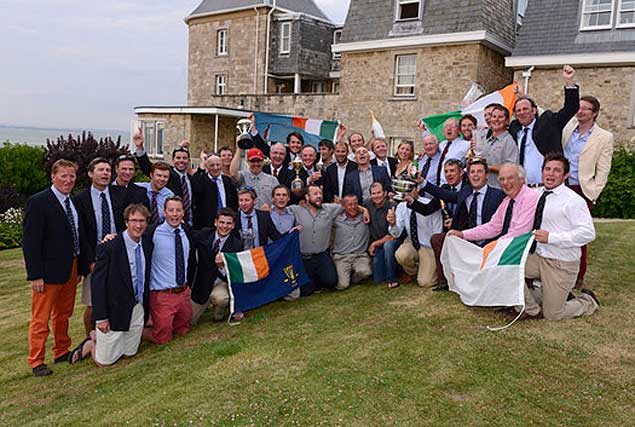 The hyper-successful Commodore’s Cup team of 2014, captained by Anthony O’Leary, celebrate on the lawns of the Royal yacht Squadron
The hyper-successful Commodore’s Cup team of 2014, captained by Anthony O’Leary, celebrate on the lawns of the Royal yacht Squadron
But while this was a highlight of Fintan Cairns’ international involvement, he’d remained active with Dublin Bay SC back home, and before standing down as Commodore he’d put in place a regular winter series, The Turkey Shoot, which he unashamedly based on the Brass Monkey series in Howth which had been running for years, and in which he had frequently competed.
However, while the Howth series has moved on a little from its light-hearted early approach – “anyone making a protest will not be eligible for a prize - with the current inclusion of serious IRC classes, the Turkey Shoot over which Cairns continues to maintain a direct personal interest is determinedly user-friendly, and of course with Dun Laoghaire’s huge home fleet, it effortlessly achieves significant numbers on Sunday mornings in the run-up to Christmas.
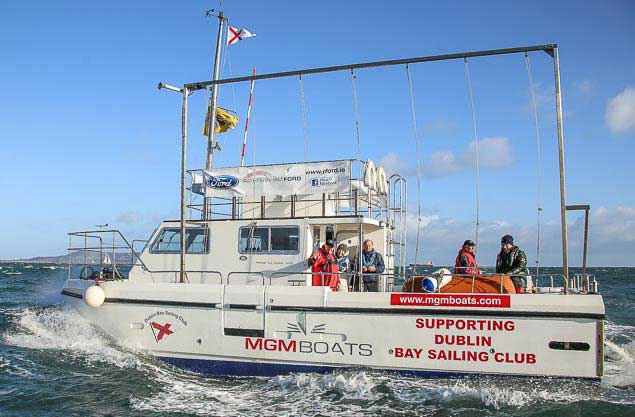 DBSC’s Freebird – Fintan Cairns and his team put to sea, November 2017. Photo David O’Brien/Afloat
DBSC’s Freebird – Fintan Cairns and his team put to sea, November 2017. Photo David O’Brien/Afloat
But although he gives time to personally running it from the Committee Boat, for the past six years Fintan Cairns’ own sailing has taken a new turn, as he has finally become a yacht owner. Admittedy it is with four other regular shipmates in a five-way syndicate including longtime sailing friends such as Denis Hewitt and Paul Bradley, all of whom bring special skills to the maintenance and running of the boat. But then, this is one very special boat, as she is Raptor, originally Aztec, one of Mark Mills’ earliest designs, and built in 1996 in Malahide by David Harte and Garrett Connolly.
With such talents involved at a key period in their individual careers, Raptor is arguably a modern classic. She’s a big-hearted boat, and though a smidgin under 32ft in overall length, she seems much bigger, and certainly has a challenging rating. But then her loving owners have lavished all sorts of goodies on her such as a carbon mast, while sailmaker Des McWilliam has provided special attention for a team with which he empathises well, and there’s always original builder David Harte generous with helpful advice when it’s needed too.
Thus with the annual DBSC Turkey Shoot the only event in which Fintan Cairns is now administratively involved, he has stood well back from the hurly-burly of the year round commitment which was required with Dublin Bay SC – where Commodore Chris Moore presides over the annual Prize-Giving, a mega event - while ICRA is now several changes down the line since the hectic times of rapid growth when he was Commodore from 2003 to 2009.
His successor Barry Rose of Crosshaven having been succeeded by Nobby Reilly of Howth who in turn was succeeded by Simon McGibney of Foynes, it’s the successful Foynes skipper who will preside next year over the ICRA Nationals at Galway from 15th to 18th August in a linkup with the WIORA Nationals 2018, a combination which was last seen at Tralee in 2013.
It offers a potentially extremely busy season for a very active younger crew, but for the senior sailors with Raptor, user-friendly rather than heads-on hyper-competitive events is what they now seek. The boat operates in a manageable setup, as Fintan Cairns – having retired from business two years ago – has moved from his south Dublin suburban home, and he and Hilary have settled comfortably into a fourth floor apartment overlooking Dun Laoghaire Harbour where Raptor is within easy reach. Fintan is expected to co-ordinate the running of the boat, as his fellow syndicators have designated him the team’s desk jockey while they get on with their various specialist tasks in her maintenance.
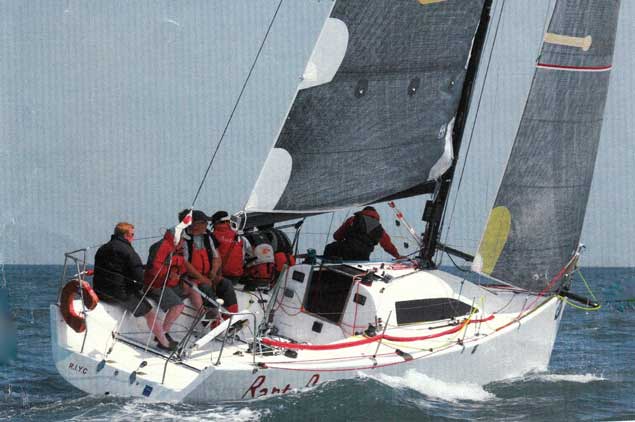 Raptor – a modern classic, much-loved by her syndicate of five owners. Originally Aztec, she was designed by Mark Mills and built by David Harte and Garrett Connolly in 1996 for Peter Beamish
Raptor – a modern classic, much-loved by her syndicate of five owners. Originally Aztec, she was designed by Mark Mills and built by David Harte and Garrett Connolly in 1996 for Peter Beamish
They’ll continue to do the Dublin Bay SC Thursday night racing, but as far as the big events are concerned, there’s a real change of pace in recent years which will be emphasised in 2018, as they’ll be doing Volvo Cork Week in July, but with new enthusiasm in the Coastal Division for the first time, and with old friend Barry Rose aboard with them. And then, as there’s just a chance that their hero Davy Harte might join them if they can get to Schull, Calves Week at the beginning of August - that perfect mixture of sport, holiday and a lovely rural setting - could well come up on the agenda.
For a young-hearted crew with decidedly senior sailors, it’s an ideal easily-implemented programme. And with his many (and continuing) quietly-made yet very effective contributions to the development of Irish sailing for more than three decades, it’s a rich fabric of sailing enjoyment which Fintan Cairns and his wide circle of friends and shipmates will very deservedly enjoy.



























